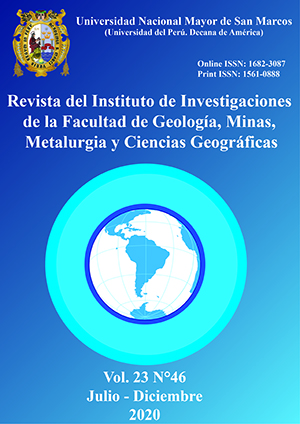Slope Stability of the Open Pit Jésica considering the Isotropic and Anisotropic Rock Mass
DOI:
https://doi.org/10.15381/iigeo.v23i46.17331Keywords:
Hydrotermal alteration, anisotropic, slope stability, isotropic, rock massAbstract
The research paper analyzes the stability of the global slope, in six types of hydrothermal alteration present in the open pit Jésica, identifies the isotropic rock mass, that is, it does not have preferential orientation of discontinuities and anisotropic taking into account the parallel or sub-parallel discontinuities to the slope. For the slope stability analysis of the isotropic and anisotropic rock mass, the Generalized Hoek-Brown and Generalized Anisotropic failure criteria were used respectively, both in Slide 6.0 software.
Two sets of discontinuities sub-parallel to the slope were considered in the anisotropic stability analysis F1 (dip from 72° to 82°) y F2 (dip from 45° to 55°). The safety factors obtained considering the anisotropic rock mass are up to 29% lower than those obtained in the isotropic rock mass; as well as the higher quality of the rock mass, the greater the variation of the safety factors, this difference is more marked in the sulphides zone with the set F2, where in a rock mass with RMR 40 the safety factor decreases by 8%, while in a rock mass with RMR 61 the safety factor decreases by 29%.
Downloads
Published
Issue
Section
License
Copyright (c) 2020 Editta Herrera Carranza, Lloyd Williams Solórzano Poma

This work is licensed under a Creative Commons Attribution-NonCommercial-ShareAlike 4.0 International License.
AUTHORS RETAIN THEIR RIGHTS:
a. Authors retain their trade mark rights and patent, and also on any process or procedure described in the article.
b. Authors retain their right to share, copy, distribute, perform and publicly communicate their article (eg, to place their article in an institutional repository or publish it in a book), with an acknowledgment of its initial publication in the Rev. Inst. investig. Fac. minas metal cienc. geogr.
c. Authors retain theirs right to make a subsequent publication of their work, to use the article or any part thereof (eg a compilation of his papers, lecture notes, thesis, or a book), always indicating the source of publication (the originator of the work, journal, volume, number and date).






